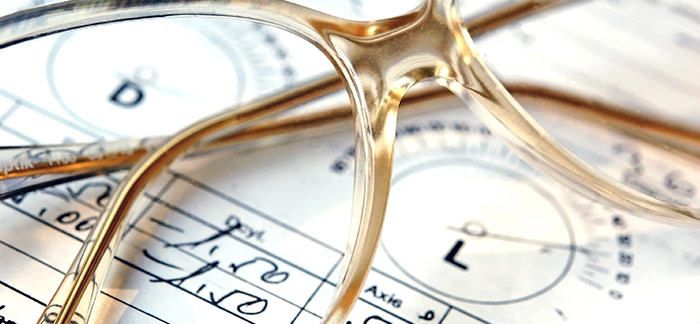|
You’ve just had your annual eye examination, you’re feeling good about having ticked another health-check off your list and you’ve even been given a fancy prescription that explains everything about the condition of your eyes - but you have no idea what it actually means. Being told you need spectacles is one thing but being able to understand why could go a long way to preserving your eye health. When we know how to read data we’re better able to ask health care professionals more informed questions. So here’s the breakdown you need on eye prescriptions, to ask the best questions and understand exactly why your eyes have been getting up to mischief.
|
|
In General
|
|
The most common eye conditions that appear on glasses prescriptions are myopia (or nearsightedness; distance vision is blurry), presbyopia (farsightedness; near vision is blurry), astigmatism (focuses light on multiple spots on the retina, making vision blurry).
|
|
Breaking down the eye lingo
|
|
A prescription is a recommended practical correction that can be implemented to assist with clearer vision.
|
|
OD |
Indicates that the prescription is for your right eye.
|
|
|
OS |
Indicates that the prescription is for your left eye.
|
|
|
OU |
Refers to both eyes.
|
|
|
D |
Distance vision - a prescription to correct your distance vision.
|
|
|
NV |
Near vision - a prescription for reading only.
|
|
|
|
|
The prescription alphabet breakdown
|
|
A typical prescription will look like this:
|
 |
|
|
SPH
|
|
The spherical correction, which refers to the degree of your near/farsightedness. If there is a minus sign below SPH you are nearsighted and if there is a plus sign, as in the example, you are farsighted. The higher the number on the prescription (the highest being 20), the worse your eyesight, which means you need a greater correction to your vision. This number plays a role in your choice of frames; a higher prescription calls for a greater curve of the lens.
|
|
CYL
|
|
The degree of astigmatism you have (when the eye isn’t completely round and causes visual distortion). A lower number means your eyes are not exactly round and a higher number means your eyes are more oval. If the column under CYL is empty it means you have no astigmatism.
|
|
AXIS
|
|
This is the direction of your astigmatism. The number that appears here represents degrees, so if it says 180 it means the astigmatism is horizontal. This is the information the lab uses to ensure they position your lenses correctly. If you don’t have astigmatism this section will be blank.
|
|
PRISM
|
|
This means your eyes don’t see clearly together, however when you cover one eye you have clear vision. The lens correction for prism in the eye aims to prevent double vision. If a prism is present one of the following will appear: BU = base up; BD = base down; BI = base in (toward the wearer's nose); BO = base out (toward the wearer's ear).
|
| BASE |
|
This information directs the lab where in the lens to place the prism and is noted in millimeters, usually between 8 and 10.
|
|
ADD
|
|
Applies to multifocal lenses when a correction to presbyopia is required. If a measurement appears under ADD it means you require different prescriptions for distance and reading.
|
|
|
Contact lens prescriptions
|
|
Eyeglass lens and contact lens prescriptions are not the same because spectacle lenses are positioned approximately 12 millimeters from the eyes and contact lenses rest directly on the surface of the eyes. When contact lenses are required or preferred, you’ll receive a separate script specific to contact lenses upon your contact lens consult.
Now that you have a better understanding of the seemingly foreign eye prescription numbers and letters, your eye health reports should appear less daunting to you. So, keep up those annual visits to the optometrist and you’ll preserve your vision for longer.
|
|

